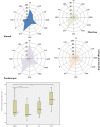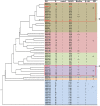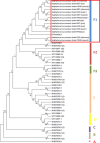Clonal diversity and spatial dissemination of multi-antibiotics resistant Staphylococcus aureus pathotypes in Southwest Nigeria
- PMID: 33621256
- PMCID: PMC7901740
- DOI: 10.1371/journal.pone.0247013
Clonal diversity and spatial dissemination of multi-antibiotics resistant Staphylococcus aureus pathotypes in Southwest Nigeria
Abstract
Spread of genetically diverse Staphylococcus aureus characterized with multi-antibiotic resistance and regulated by high level agr functionalities in several communities in southwest Nigeria was investigated and evaluated for infection control. Staphylococcus aureus pathotypes recovered from 256 cases including purulent pus from skin infections, soft tissue aspirates, wounds, otorrhea, eye, throat and endocervical infections were assayed for biofilm and antibiogram. Further genotyped with micro-array, mapped for geospatial distribution and evaluated for clonal diversity and functional accessory gene regulators (agr). Significant Staphylococci infection among the ages (OR:0.021, CI:0.545-1.914) and female gender with prevalence rate of MSSA (53.0%) and MRSA (1.5%) (OR:1.021, CI:0.374-1.785) were observed. More than 52.5% resistance rates to tetracycline and amoxicillin with significant median resistance were observed in all the infection cases (p = 0.001). Resistance rate of 78.8% at MIC50 32μg/ml and MIC90 128μg/ml to amoxicillin-clavulanate, and more than 40% resistance to ceftazidime, ciprofloxacin and tetracycline of MIC90 and MIC50 at 32 μg/ml were observed. Strains with multi-antibiotic resistance index above 0.83, high beta-lactamase and strong biofilm clustered into separate phylo-group. Heterogeneous t442 (wound and pus), t657 (wound), t091 (ear) and t657 (ear and wound) revealed high phylogenetic diversity. Only 4.6% pvl+ MSSA-CC1 agrI, pvl+ MSSA-CC5 (13.6%) and pvl+ MRSA-CC7 agrII (4.6%), expressed enterotoxin, leukocidins, proteases and resistance gene determinants. Livestock clonal types clustered with identified community-associated strains. Clonal dissemination of resistant pvl+ MSSA-CC1 and MRSA-CC5 encoding agr were predominant in several peri-urban communities where adequate geno-surveillance, population-target antimicrobial stewardship, extensive community structured infection control programs are needed to prevent further focal dissemination.
Conflict of interest statement
The authors have declared that no competing interests exist.
Figures




Similar articles
-
A meta-analysis on the prevalence of resistance of Staphylococcus aureus to different antibiotics in Nigeria.Antimicrob Resist Infect Control. 2023 Apr 25;12(1):40. doi: 10.1186/s13756-023-01243-x. Antimicrob Resist Infect Control. 2023. PMID: 37098614 Free PMC article. Review.
-
Pathogenomic profile and clonal diversity of potential zoonotic MRSA-CC7-ST789-t091-SCCmecV from human skin and soft tissue infections.Sci Rep. 2024 Aug 20;14(1):19326. doi: 10.1038/s41598-024-67388-w. Sci Rep. 2024. PMID: 39164371 Free PMC article.
-
Clonal diversity and genomic characterization of Panton-valentine Leukocidin (PVL)-positive Staphylococcus aureus in Tehran, Iran.BMC Infect Dis. 2021 Apr 21;21(1):372. doi: 10.1186/s12879-021-06060-4. BMC Infect Dis. 2021. PMID: 33882854 Free PMC article.
-
Genetics of bi-component leukocidin and drug resistance in nasal and clinical Staphylococcus aureus in Lagos, Nigeria.Microb Pathog. 2018 Feb;115:1-7. doi: 10.1016/j.micpath.2017.12.030. Epub 2017 Dec 12. Microb Pathog. 2018. PMID: 29246634
-
Correlation Between Biofilm Formation and Antibiotic Resistance in MRSA and MSSA Isolated from Clinical Samples in Iran: A Systematic Review and Meta-Analysis.Microb Drug Resist. 2020 Sep;26(9):1071-1080. doi: 10.1089/mdr.2020.0001. Epub 2020 Mar 10. Microb Drug Resist. 2020. PMID: 32159447
Cited by
-
A meta-analysis on the prevalence of resistance of Staphylococcus aureus to different antibiotics in Nigeria.Antimicrob Resist Infect Control. 2023 Apr 25;12(1):40. doi: 10.1186/s13756-023-01243-x. Antimicrob Resist Infect Control. 2023. PMID: 37098614 Free PMC article. Review.
-
Loop-Mediated Isothermal Amplification of DNA (LAMP) as an Alternative Method for Determining Bacteria in Wound Infections.Int J Mol Sci. 2023 Dec 28;25(1):411. doi: 10.3390/ijms25010411. Int J Mol Sci. 2023. PMID: 38203582 Free PMC article. Review.
-
Evaluation of Efflux-Mediated Resistance and Biofilm formation in Virulent Pseudomonas aeruginosa Associated with Healthcare Infections.Antibiotics (Basel). 2023 Mar 22;12(3):626. doi: 10.3390/antibiotics12030626. Antibiotics (Basel). 2023. PMID: 36978493 Free PMC article.
-
Nasal Carriage, Antimicrobial Susceptibility Profile, and Enterotoxin Genes of Staphylococcus aureus Isolated from Children with Asthma.Indian J Microbiol. 2024 Sep;64(3):1144-1152. doi: 10.1007/s12088-024-01272-z. Epub 2024 Apr 18. Indian J Microbiol. 2024. PMID: 39282162
-
Antibacterial activities of plant leaf extracts against multi-antibiotic resistant Staphylococcus aureus associated with skin and soft tissue infections.BMC Complement Med Ther. 2022 Feb 21;22(1):47. doi: 10.1186/s12906-022-03527-y. BMC Complement Med Ther. 2022. PMID: 35189869 Free PMC article.
References
-
- Asadollahi P, Farahani NN, Mirzaii M, Khoramrooz SS, van Belkum A, Asadollahi K, et al. Distribution of the Most Prevalent Spa Types among Clinical Isolates of Methicillin-Resistant and–Susceptible Staphylococcus aureus around the World: A Review. Front. Microbiol. 2018, 9:163 10.3389/fmicb.2018.00163 - DOI - PMC - PubMed
-
- Goudarzi M., Seyedjavadi S. S., Nasiri M. J., Goudarzi H., Nia R. S., and Dabiri H. Molecular characteristics of methicillin-resistant Staphylococcus aureus (MRSA) strains isolated from patients with bacteremia based on MLST, SCCmec, spa, and agr locus types analysis. Microb. Pathog. 2017, 104, 328–335. 10.1016/j.micpath.2017.01.055 - DOI - PubMed
-
- Fernández-Barat L, Ben-Aicha S, Marco F, Motos A, Vila J, Rigol M, et al. Assessment of in vivo versus in vitro bioilm formation of clinical methicillin-resistant Staphylococcus aureus isolates from endotracheal tube. Scientific Report, 2018, 8:11906–10. 10.1038/s41598-018-30494-7 - DOI - PMC - PubMed
Publication types
MeSH terms
Substances
LinkOut - more resources
Full Text Sources
Other Literature Sources
Medical

